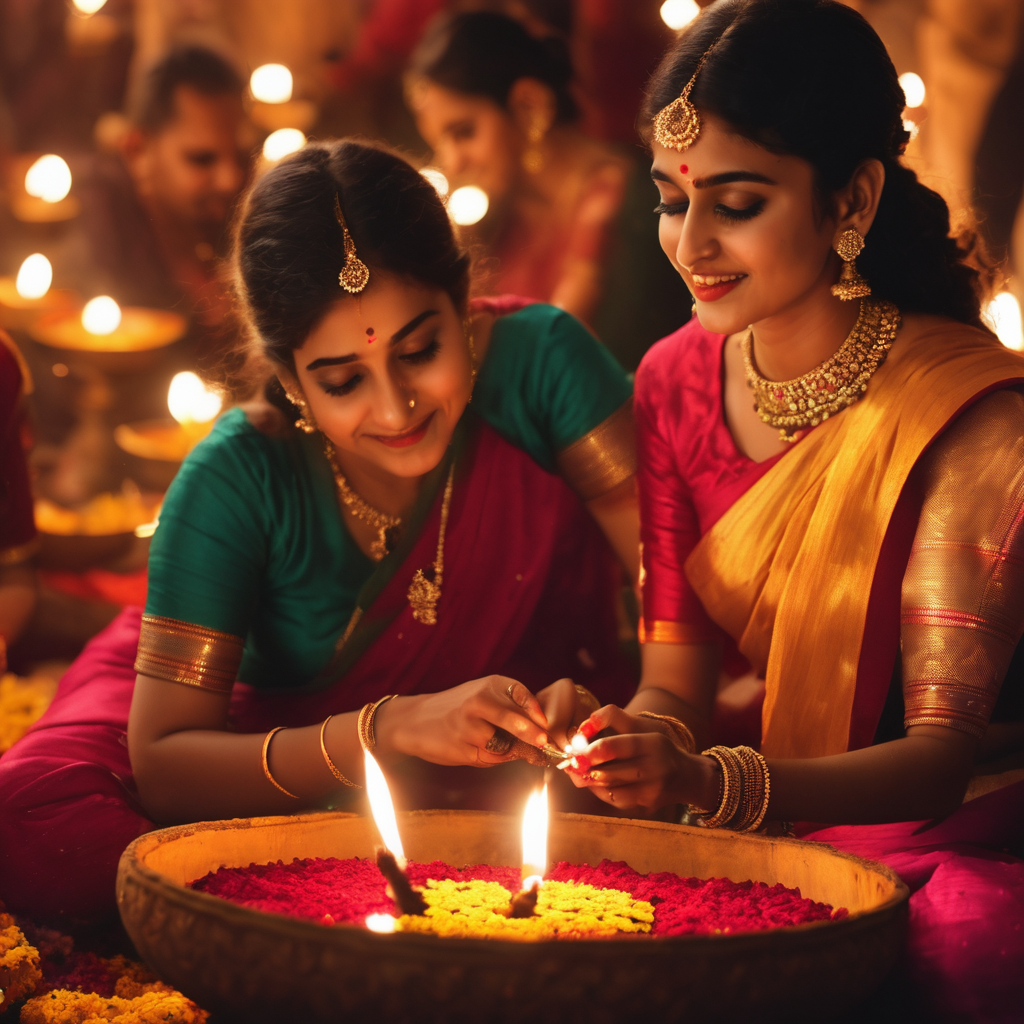Diwali, the festival of lights, is more than just an occasion for dazzling displays of lamps and fireworks. It is a time of profound significance, steeped in traditions and rituals that add depth and meaning to the celebrations. Let’s take a closer look at the various traditions and rituals that define the essence of Diwali and make it a cherished time for millions.
1. Cleaning and Decorating Homes

The preparations for Diwali begin weeks in advance with thorough cleaning of homes. This is not just about maintaining cleanliness but also symbolizes the removal of negativity and impurity from one’s life. It’s a time to declutter and decorate homes with rangoli, fresh flowers, and colorful lanterns. The goal is to create an environment that is not only aesthetically pleasing but also spiritually uplifting.
2. Lighting Diyas and Candles

As the sun sets, the lighting of diyas (oil lamps) and candles is a central ritual of Diwali. These tiny flames not only illuminate homes but also symbolize the triumph of light over darkness and good over evil. The glow of diyas is believed to dispel negativity and invite positivity into one’s life. The entire family comes together to light these lamps, creating a beautiful and warm ambiance.
3. Bursting Firecrackers

Fireworks are an integral part of Diwali celebrations. The colorful and dazzling displays in the night sky are a visual treat, and the sound of crackers fills the air with excitement. While this tradition adds to the festive atmosphere, it’s important to note that there is growing concern about the environmental impact and safety issues associated with firecrackers. In recent years, there has been a shift towards celebrating a more eco-friendly Diwali by minimizing the use of fireworks.
4. Exchanging Gifts
The tradition of exchanging gifts during Diwali is a delightful way of expressing love and goodwill. It’s a time when people exchange sweets, dry fruits, and other thoughtful presents with friends and family. The act of giving and receiving gifts strengthens bonds and spreads joy.
5. Preparing and Sharing Sweets

Diwali is synonymous with an array of mouthwatering sweets and snacks. Preparing these delectable treats at home is a cherished tradition. Families cook an assortment of sweets like laddoos, jalebis, and barfis. It’s also common to share these sweets with neighbors and friends, reinforcing the spirit of togetherness and sharing.
6. Performing Puja (Prayer) and Offering Prayers
Religious rituals play a significant role in Diwali celebrations. Families perform pujas, or prayers, to invoke blessings from deities. Goddess Lakshmi, the goddess of wealth and prosperity, is especially worshipped during Diwali. The prayers are often followed by an aarti, which involves the offering of lamps to the deities. This is a time for reflection, expressing gratitude, and seeking divine blessings for a prosperous year ahead.
7. Gambling and Playing Games
In some regions of India, gambling is considered an essential part of Diwali celebrations. It is believed that playing games of chance during Diwali brings good luck and prosperity. Traditional card games like teen patti and rummy are popular during this time, and families often gather for friendly matches.
8. Visiting Temples and Seeking Blessings
Many people visit temples on Diwali, seeking blessings and offering their prayers. Temples are beautifully decorated, and the spiritual ambiance is heightened during this time. Devotees light lamps and incense sticks, making their offerings to the deities.
9. Worshiping Tools and Instruments
In some regions, Diwali is an occasion to worship tools and instruments. It is believed that these tools are essential for one’s livelihood and should be honored. On this day, farmers worship their plows, traders venerate their accounting books, and craftsmen pay homage to their tools.
10. Lakshmi Puja and the Lighting of Lamps
On the main day of Diwali, families conduct a special puja dedicated to Goddess Lakshmi, who is associated with wealth and prosperity. This puja is performed in the evening, and during the ritual, lamps are lit, and offerings are made. It is a time to seek the blessings of Goddess Lakshmi for financial well-being and a prosperous future.
11. Celebrating Diwali Over Five Days
Diwali is not limited to a single day; it’s a five-day festival. The festivities commence with Dhanteras, followed by Naraka Chaturdashi (Choti Diwali), the main Diwali day, Govardhan Puja, and conclude with Bhai Dooj. Each day has its own set of traditions and rituals, making the entire week a time of joy and festivity.
12. Rangoli and Kolam Designs

One of the most artistic and colorful aspects of Diwali is the creation of rangoli and kolam designs. These intricate patterns are drawn on the ground outside homes, using colored powders, rice, flower petals, or chalk. Rangoli designs vary from simple and traditional to highly complex and artistic, reflecting regional and personal preferences.
Diwali is a festival that is deeply rooted in tradition and symbolism. From the cleaning of homes to the lighting of lamps, the exchange of gifts, and the offering of prayers, each aspect of Diwali has its own significance. The traditions and rituals of Diwali not only add depth to the celebrations but also serve as a reminder of the festival’s core messages of light, unity, and the triumph of good over evil.
As we embrace these customs and rituals, we not only partake in a grand celebration but also contribute to the preservation of a rich cultural heritage that has been cherished for generations. Diwali is not just a festival; it is a living tradition that connects us with our roots and strengthens the bonds of family and community. It is a time of togetherness, reflection, and the spreading of joy and positivity, making it one of the most beautiful and meaningful festivals in the world.

